Books
Books
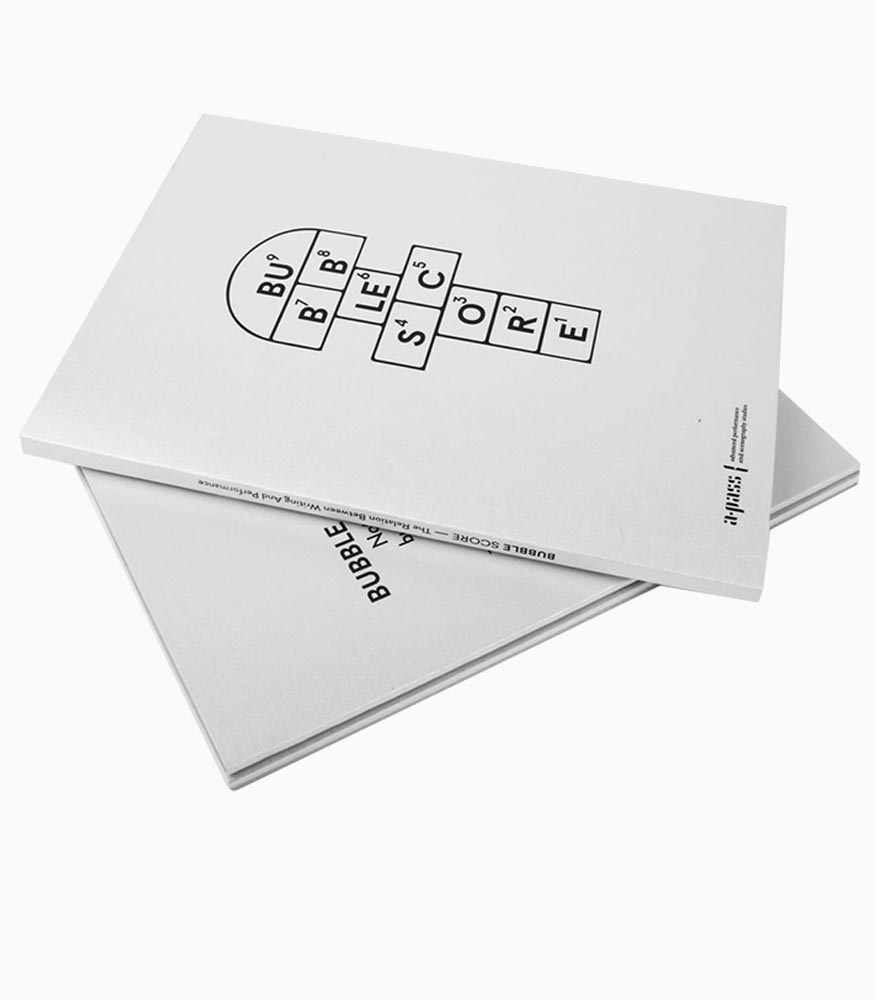
Writing Scores / Bubble Score / Perform Back Score / Scorescapes (set)
The book Writing Scores is the result of 3 months of written dialogues produced within the group of artistic researchers of a.pass during the Block I /2014 curated by Lilia Mestre. Questions on art, dreams, politics, violence, research, life, practice, bureaucracy, resistance, etcetera, … are addressed and later on re-addressed, revisited and assembled into a book with (at least) three faces…
BUBBLE SCORE – The Relation between Performance and Writing is the third book of the ScoreScapes publications series. The book contains texts by a.pass researchers, collages as well as Scores for the Reader inserted at the back of the book.
The book Perform Back Score is the result of 3 months of performed, sketched and written dialogue produced within a group of artistic researchers, each plunging into a study about the Conditions for the Emergence of Poetics. Poetics used here as ‘acts’ that transform our ways of perceiving, as situations that invite another understanding of ‘things’.

Another Version: Thinking through Performing
ANOTHER VERSION: Thinking Through Performing approaches performance as a method of producing different versions of the self, referred to as ‘versioning’. It explores technologies and processes that produce such versions, and asks the question of how to understand the self within this multiplicity. ANOTHER VERSION: Thinking Through Performing proposes strategies of versioning as a means of attaching gesture, speech or lived experience to research questions or problems.
It is comprised of 7 cahiers containing games, scores, short stories, images, quotes and reflections that are often products of collaborative practices. Each cahier opens up a particular territory or lens, indicated through its title: CAHIER I Multiplicators, CAHIER II Pandiculators, CAHIER III Arena, CAHIER IV Objectaffilia, CAHIER V Animalities and CAHIER VI Ledger.
The content of each cahier is structured into eight categories: conversation, image as score, notes, quote, reference text, report, score and short story. These can be used as the reader/user sees fit, a story, an image or a quote can be used as a score, a score can be reversed or a reflection can be cut up and transformed into a new text.
Cahier 0 reflects and expands on the content of the publication and the research from which it springs. It contains a conversation Multiplicity, Multiplicators and the Supermarket Scorebetween Philippine Hoegen and Sebastian Olma, and an essay Ecstatic Methods — Seven Vectors Addressed to Philippine Hoegen by Kristien Van den Brande.

Return To Leptis Magna
Anna Barham’s Return To Leptis Magna is a book which compiles anagrams of the title sentence. We designed the rules which allowed the artist to compose the book, including a typeface which has different letterforms for characters that appear more than once, so that each letter is unique.
Design by Anna Barham & Julia. Typeset in Leptis, designed by Julia.

Poisonous Oysters
The material in Poisonous Oysters was generated during a live production reading group held in Newcastle University’s Fine Art Department on 26.01.18. Passages from the texts listed below were read aloud by the participants and interpreted by speech recognition software over and over, creating a poly-vocal feedback loop with the machine. The output is rewritten here as a score, flattening the time of the event and aligning the different versions of the texts to reveal the sound mutations between them.
Precarious Life, Judith Butler
The Waves, Virginia Woolf
Vampyroteuthis Infernalis, Vilém Flusser
Body Pressure, Bruce Nauman
Testo Junkie, Beatriz Preciado
The Politics of Translation, Gayatri Spivak
Creating trance and hypnosis scripts, Gemma Bailey
Untitled document, John Latham
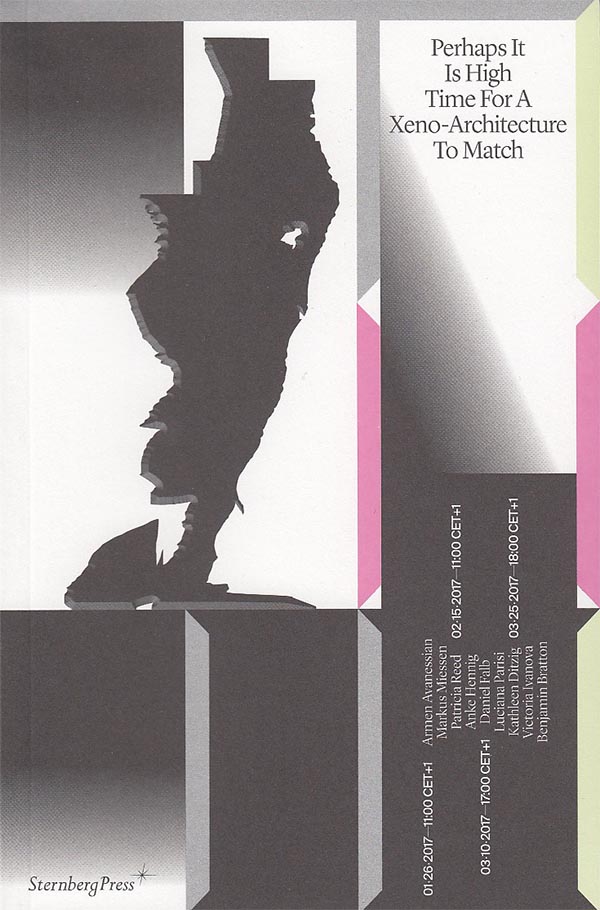
Perhaps It Is High Time for a Xeno-architecture to Match
Armen Avanessian, Lietje Bauwens and 3 more
“Xeno” speaks to the turn away from “what is” toward “what could be”: the (as yet) unknown, the alien—having been employed in recent years through such speculative-political approaches as xenofeminism and xenopoetics. Perhaps It Is High Time for a Xeno-architecture to Match documents a conversation series from January to March 2017 that explored what an intervention of the xeno might bring to bear on contemporary and future (infra)structure.
This book aims to unpack the prefix, probing what it entails—not merely rhetorically but also as a means of practice, in an attempt to bring the ideas it contains more concretely into the domain of architecture. It proposes to link the more philosophical discussions on the notion of xeno with questions of instrumentalization and governance that are necessarily involved in the praxis of architecture. And it relates the significance of legal architecture and technologically driven transformation in the metaphysics of law back to the agenda of xeno-architecture. By researching how architects, artists, thinkers, and activists operating in the spatial field might endorse a process of “alienation” to confront global issues, this project attempts to re-radicalize spatial practice.
Contributions by ARMEN AVANESSIAN, BENJAMIN BRATTON, KATHLEEN DITZIG, DANIEL FALB, ANKE HENNING, VICTORIA IVANOVA, MARKUS MIESSEN, LUCIANA PARISI, PATRICIA REED.

Wimper
Alex Farrar’s book Wimper (the Dutch term for eyelash, or a potential misspelling of the English for ‘whimper’) presently held by the reader is an extension of an exhibition, which may be experienced in its own right, after the space has been vacated. It operates on the limits of material evidence by reprising a series of earlier prints entitled Behavioural Residues (second sweep), featuring barely perceptible images of single eyelashes spread throughout the texts and pages. Apart from their significance as intimate materials discarded by the body over time, such as hair or skin, they submit to the almost nothing of an aesthetics of disappearance, while lingering in a dialectics of misunderstanding that commits to a lack of closure.
Texts by Nicolas de Oliveira and Nicola Oxley, and David Price. Graphic design by studio Hendriksen, risograph printed by Alex Farrar in studio Hendriksen, Amsterdam, with the cover offset printed by ZwaanLenoirSchuring and bound by AGIA (The Netherlands) in a print run of 300 copies.
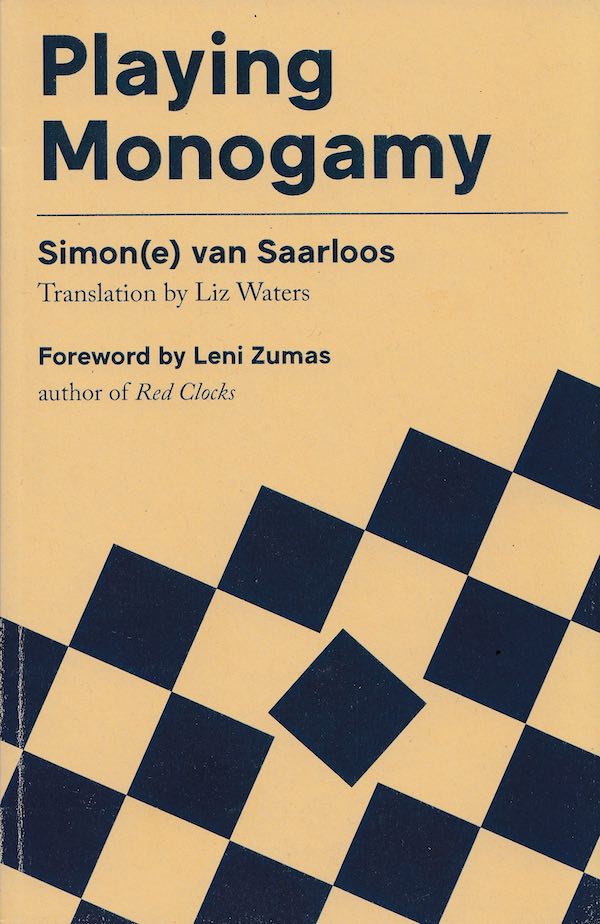
Playing Monogamy
Love is love, but not really. To recognise love as love we need comprehensible images. What are those contemporary images that help us identify love and how could we identify love differently, figuring it as less defined by safety procedures, measured commitment and feelings of ownership and entitlement? Playing Monogamy refuses to see personal relationships as safe havens where people can hide from the precarities of society, and instead proposes to make public life more intimate and romantic.
Through a contemporary rereading of the cult of monogamy, van Saarloos playfully queers the way in which the structure of monogamy is upheld through social convention within Western contexts. Written for more of a lay audience, the book proposes an expanded and polyamorous engagement with intimacy and sexuality as a possible alternative. Originally written in Dutch and published by De Bezige Bij, Publication Studio is excited to bring this book to an English speaking audience for the very first time.
Translated by Liz Waters, it includes a foreword by Leni Zumas, author of the US bestseller Red Clocks, and a revised preface by Simon(e) herself, addressing how she might approach writing about nonmonogamy differently four years after the book's first publication—and after many experiences in between.

The Baudelaire Fractal
One morning, Hazel Brown awakes in a badly decorated hotel room to find that she's written the complete works of Charles Baudelaire. In her bemusement the hotel becomes every cheap room she ever stayed in during her youthful perambulations in 1980s Paris ... This is the legend of a she-dandy's life. Part magical realism, part feminist ars poetica, part history of tailoring, part bibliophilic anthem, part love affair with nineteenth-century painting, The Baudelaire Fractal is poet and art writer Lisa Robertson's first novel.
'As far as I'm concerned, it's already a classic.' - Anne Boyer

Under Current
Companion reader for Under Current, an exhibition and film by Alice dos Reis. With 'Blue Carbon' by Holly Childs, 'Hydrofeminism: Or, On Becoming a Body of Water' by Astrida Neimanis, 'King Tide' by Sophia Al-Maria, 'Notes on a Dotted Red Wave' by Danea Io, 'Smart Oceans, Alien Times: Octopi Engineering' by Bogna M. Konior, 'To a Current's Ear' by Alice dos Reis and more. Bilingual edition (Spanish-English).

MxT
MxT, or ‘Memory x Time,’ is one of the formulas acclaimed poet Sina Queyras posits as a way to measure grief. These poems mourn the dead by turning memories over and over like an old coin, by invoking other poets, by appropriating the language of technology, of instruction, of diagram, of electrical engineering, and of elegy itself.

the project
the project - a project about love and intimacy. 'It is a method that touches on (or rather, crashes into) some (artistic) ‘taboo’s’, surrounding the ways in which the autobiographical, one’s intimate life and those who partake in that, can and ought to be dealt with within one’s artistic work. She ‘gets away with it’ and I think the reason for that is that she doesn’t try to spare herself or seek a safety zone, nor does she shun her artistic, author’s responsibility: she is constantly both in the middle of the sticky hot soup in which she is cooking her research and she doing the stirring, the spicing and the serving.' - Philippine Hoegen

We Speak Silent
In We Speak Silent, an opus of the quirky relationships between people and their words, Hannah Weiner becomes the vessel for the emotional spectrum of the human comedy. It is a continuing adventure in language. Hannah Weiner is also the author of numerous books of poetry and prose, including The Code Poems, Clairvoyant Journal, and Little Books/ Indians.

Beyond The Periphery Of The Skin
Feminist, antiracist, trans, ecological movements: all look at the body as a ground of confrontation with the state and a vehicle for transformative social practices. Concurrently, the body has become a signifier for the reproduction crisis generated by the neoliberal turn in capitalist development and for the international surge in institutional repression and public violence. In Beyond the Periphery of the Skin, lifelong activist and bestselling author Silvia Federici examines these complex processes, placing them in the context of the history of the capitalist transformation of the body into a work-machine, expanding on one of the main subjects of her first book, Caliban and the Witch. In this process she confronts some of the most important questions for contemporary radical political projects.

Theatrum Botanicum
This publication emerges from Uriel Orlow's Theatrum Botanicum (2015-18), a multi-faceted project encompassing film, sound, photography, and installation, which looks to the botanical world as a stage for politics. Working from the dual vantage points of South Africa and Europe, the project considers plants as both witnesses to, and dynamic agents in, history. It links nature and humans, rural and cosmopolitan medicine, tradition and modernity across different geographies, histories, and systems of knowledge—exploring the variety of curative, spiritual, and economic powers of plants. The project addresses "botanical nationalism" and "flower diplomacy" during apartheid; plant migration; the role and legacies of the imperial classification and naming of plants; bioprospecting and biopiracy; and the garden planted by Nelson Mandela and his fellow inmates at Robben Island prison.

The Hundreds
Kathleen Stewart, Laurent Berlant
In The Hundreds Lauren Berlant and Kathleen Stewart speculate on writing, affect, politics, and attention to processes of world-making.
The experiment of the one hundred word constraint, each piece is one hundred or multiples of one hundred words long, amplifies the resonance of things that are happening in atmospheres, rhythms of encounter, and scenes that shift the social and conceptual ground.
What's an encounter with anything once it's seen as an incitement to composition? What's a concept or a theory if they're no longer seen as a truth effect, but a training in absorption, attention, and framing?
The Hundreds includes four indexes in which Andrew Causey, Susan Lepselter, Fred Moten, and Stephen Muecke each respond with their own compositional, conceptual, and formal staging of the worlds of the book.

Night Philosophy
Night Philosophy is collected around the figure of the child, the figure of the child not just as a little person under the tutelage of adults, but also the submerged one, who knows, who is without power, who doesn’t matter. The book proposes a minor politics that disperses all concentrations of power. Fanny Howe chronicles the weak and persistent, those who never assimilate at the cost of having another group to dominate. She explores the dynamics of the child as victim in a desensitized era, when transgression is the zeitgeist and the victim–perpetrator model controls citizens. With an afterword by Chris Kraus.
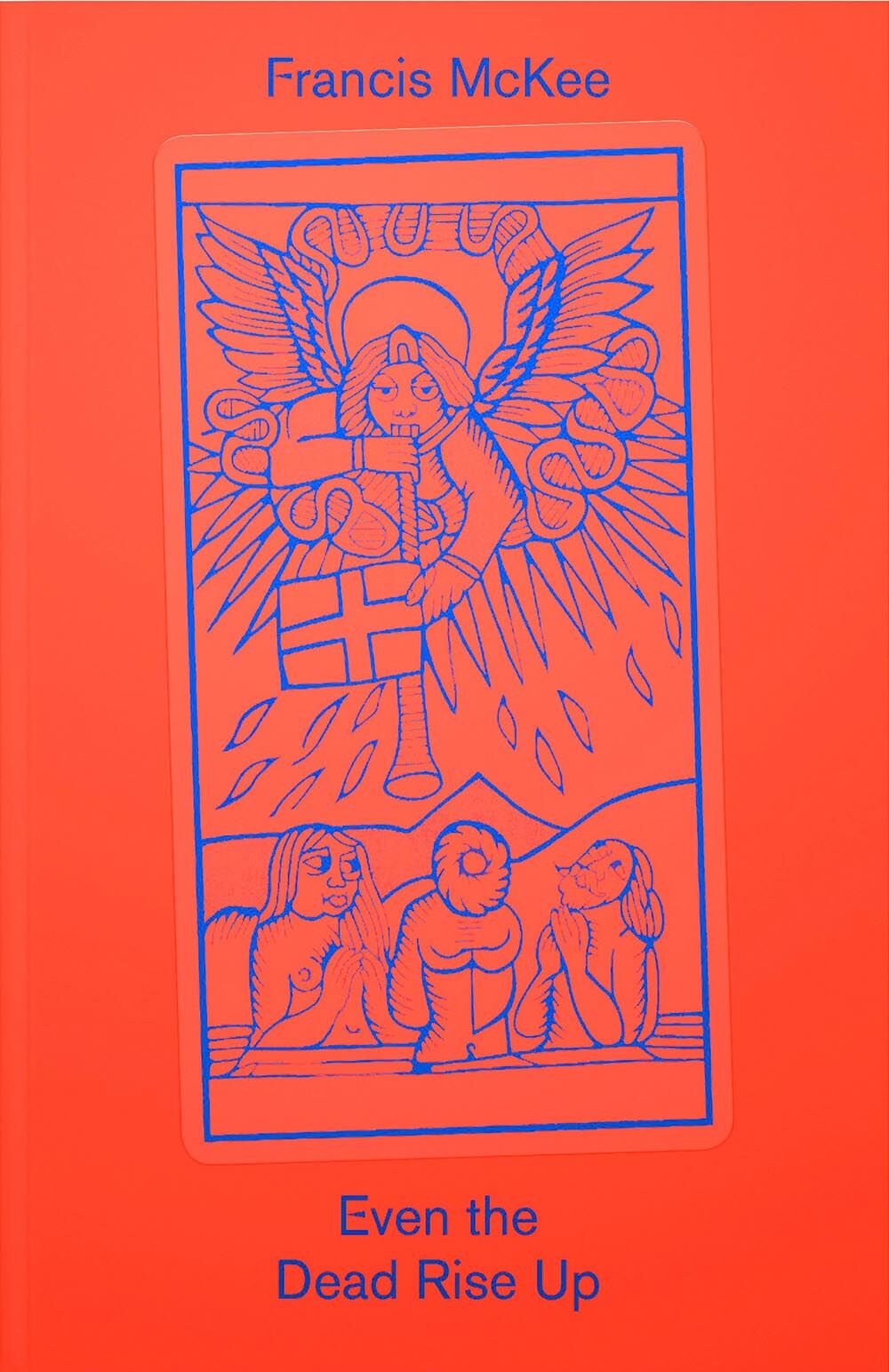
Even The Dead Rise Up
Even the Dead Rise Up, and the political becomes personal. In McKee’s first novel, observations of séances, scientific advances, group education outings, Kurdish protests for the ‘disappeared’, become mixed with his own Tarot influenced visions: a haunting spirit appears; the relation between political resistance and Spiritualism is cast as an insurrectionary force and a millenarian energy, celebrating the ecstatic moment. Histories of isolated early Christians and twentieth century mystics affect the psyche, all of this documented through journal entries that move from Scottish islands to Puerto Rico. Influenced by forms of 1960s new journalism, McKee pushes language to match the raw material of the stories, which become more erratic, signalling the looming fate of the text and its author.

Master Rock
Master Rock is a repertoire for a mountain.
Rough land, open palm. Bodies are machines that shake. Big boned faces, big hands, big claws, ah Jesus, well-used. Bore. Blast. Smash. Force on loan. Must be hard and clever to survive in this technological age. Granite knows the biological. Gods inside the mountain, just plain men outside.
Working through the cavernous space in Ben Cruachan, the largest peak on the west coast of Scotland, Maria Fusco exhumes three fictional voices from fact: Tunnel tigers, the Irish explosives experts who emptied out the mountain to build a power station; Elizabeth Falconer, the artist who produced a mural inside that only the site’s workers ever see; and Granite, the 450 million year-old rock of Cruachan itself as a main character.

Woman, Native, Other
Woman, Native, Other is located at the juncture of a number of different fields and disciplines, and it genuinely succeeds in pushing the boundaries of these disciplines further. It is one of the very few theoretical attempts to grapple with the writings of women of color. - Chandra Talpade Mohanty

The Floor Is Uneven. Does It Slope?
In 1987, artist and poet Madeline Gins (1941–2014) and her partner, painter Arakawa (1936–2010), formed the Architectural Body Research Foundation (later to become the Reversible Destiny Foundation)—an architectural office pursuing the radical conviction that architecture would provide humanity with the necessary tools and training to overcome death. Their wide variety of theories investigated how a person might interact with their environment, and how that environment might condition and enhance the body to increase its capabilities—through a constant undoing and unsettling of subject formation. Taking the work and writings of Madeline Gins and Arakawa as a broad provocation, The Floor Is Uneven. Does It Slope? aims to swallow and masticate the duo’s thought into a new sort of pulp: a collective fan fiction work. Less a book about Gins and Arakawa than a book after them, it tries to seed their work to various fans—writers and makers indebted to the duo’s thinking or suspected to be enthralled by it.
Contributors speak about Gins and Arakawa through the language of their own practice, through academia, poetry, essays, photography, experimental writing, and fiction—thinking about what Gins and Arakawa might mean to their individual fields.
Texts by Henry Andersen, Lila Athanasiadou, Ben Thorp Brown, Lucas Crawford, Bryana Fritz, Laura Herman, Daisuke Kosugi, Joyelle McSweeney, Simone C. Niquille, Andros Zins-Browne.

Verlag der Buchhandlung Walther König
Collected Interviews 1990–2018
This substantial archive offers an ideal point of entry into the work and reception of Los Angeles–based performance artist and writer Andrea Fraser (born 1965). The interview format provides particular insight into Fraser's self-positioning as a central aspect of her practice. By presenting the artist's voice as mediated through various interlocutors (ranging from professional peers to popular media), Collected Interviews, 1990–2018 uniquely contextualizes Fraser's practice in the artistic and institutional fields in which she intervenes.

Vagabondi Efficaci
The words collected in the book form a constellation of texts in which the theme of walking becomes a mode of being, a poetic disposition, to redefine one’s relationship with space-time. With words by Kathy E. Ferguson, Emily Dickinson, Sylvia Plath, Carlo Ginzburg, Fernand Deligny, John Ruskin, Susan Leigh Star & Geoffrey C. Bowke, Usrula K. Le Guin, Arthur Rimbaud, Jack Eliott Cardno, Costanza Candeloro, Axelle Stiefel, Giulia Essyad, Gianmaria Andreetta, Arnaud Wohlhauser.

i apologize
(...) There is no one on the chair, there is no hand on the table, perhaps nobody on the floor. The set up is empty, but some kind of unsettling presence is undeniable. The set up is so obviously fake that there must be something behind it. I am not going to lie: I am going to lie.
If I lie, there is a deliberated stand. I don't have to be "true", to myself, to others. My intention is not to find lying moving, but those who can never lie cannot grow either, cannot discover who they really are. The people, that every day are forced to rip off their personality into fragments, know something about themselves and about life that nobody could teach them. Lying, betraying, is to want to or be able to transform a situation, a fact, an emotion, oneself. The act of lying suddenly un-conceals what has been considered as neutral or as the reference point. The power relations already in place are being revealed, "normality" appears as hegemony. The lie embodies a transgression. It is an attempt to escape normative structures and the refusal to assimilate them. (...)
Includes contributions by Christian Noelle Charles, Andrej Dubravsky, Sandra Golubjevaite, Lewis Hammond, Tarek Lakhrissi, Nils Amadeus Lange, Floriane Michel, Stijn Pommée, Adam Ulbert
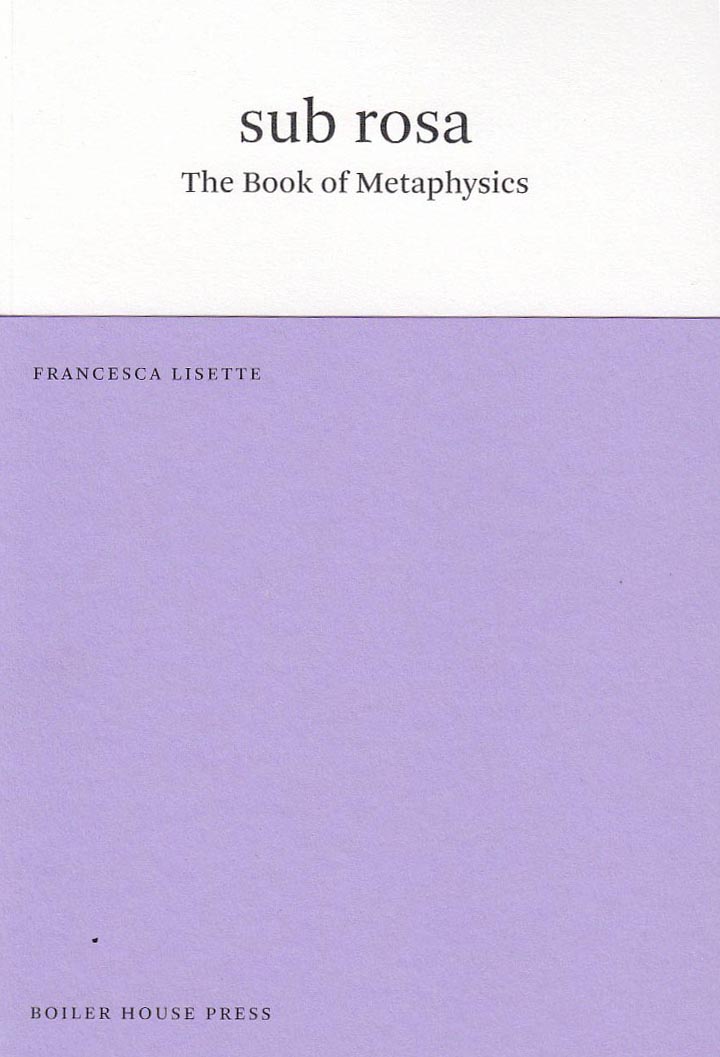
Sub Rosa
sub rosa: The Book of Metaphysics is a three-part interrogation of love, gender, ritual and the body. It heralds a new kind of poetic thinking, one that seeks to articulate and enact a mode of resistance to the obstinacy of present conditions, but which focuses on embodiment, tenderness and optimism. It wants to break present paths and contribute to a collective imagining of a different future; a record of and a practice towards healing.